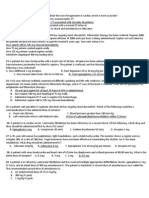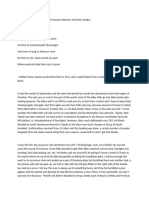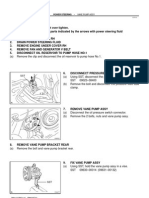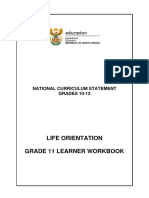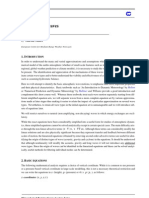ACLS - Precourse Questions and Answers
ACLS - Precourse Questions and Answers
Uploaded by
superdockkCopyright:
Available Formats
ACLS - Precourse Questions and Answers
ACLS - Precourse Questions and Answers
Uploaded by
superdockkOriginal Description:
Original Title
Copyright
Available Formats
Share this document
Did you find this document useful?
Is this content inappropriate?
Copyright:
Available Formats
ACLS - Precourse Questions and Answers
ACLS - Precourse Questions and Answers
Uploaded by
superdockkCopyright:
Available Formats
ECC
American Heart Association
Advanced Cardiovascular
Life Support
Written Precourse
Self-Assessment
October 2006
© 2006 American Heart Association
ACLS Written 2006 Precourse Self-Assessment
1. Ten minutes after an 85-year-old woman collapses, paramedics arrive and start CPR for the
first time. The monitor shows fine (low-amplitude) VF. Which of the following actions should
they take next?
a. Perform at least 5 minutes of vigorous CPR before attempting defibrillation
b. Insert an endotracheal tube, administer 2 to 2.5 mg epinephrine in 10 mL NS through the tube
and then defibrillate
c. Deliver up to 3 precordial thumps while observing the patient’s response on the monitor
d. Deliver about 2 minutes or 5 cycles of CPR, and deliver a 360-J monophasic or equivalent-
current biphasic shock
2. A cardiac arrest patient arrives in the ED with PEA at 30 bpm. CPR continues, proper tube
placement is confirmed, and IV access is established. Which of the following medications is
most appropriate to give next?
a. Calcium chloride 5 mL of 10% solution IV
b. Epinephrine 1 mg IV
c. Synchronized cardioversion at 200 J
d. Sodium bicarbonate 1 mEq/kg IV
3. Which of the following actions helps deliver maximum current during defibrillation?
a. Place alcohol pads between the paddles and skin
b. Reduce the pressure used to push down on the defibrillator paddles
c. Apply conductive paste to the paddles
d. Decrease shock energy after the 2nd shock
4. Which of the following actions is NOT performed when you “clear” a patient just before
defibrillator discharge?
a. Check the person managing the airway: body not touching bag mask or tracheal tube, oxygen
not flowing directly onto chest
b. Check yourself: hands correctly placed on paddles, body not touching patient or bed
c. Check monitor leads: leads disconnected to prevent shock damage to monitor
d. Check others: no one touching patient, bed, or equipment connected to patient
ACLS Precourse Written Self-Assessment 2
© 2006 American Heart Association
5. A woman with a history of narrow-complex PSVT arrives in the ED. She is alert and oriented
but pale. HR is 165 bpm, and the ECG documents SVT. BP is 105/70 mm Hg. Supplemental
oxygen is provided, and IV access has been established. Which of the following drug-dose
combinations is the most appropriate initial treatment?
a. Adenosine 6 mg rapid IV push
b. Epinephrine 1 mg IV push
c. Synchronized cardioversion with 25 to 50 J
d. Atropine 1 mg IV push
6. Which of the following facts about identification of VF is true?
a. A peripheral pulse that is both weak and irregular indicates VF
b. A sudden drop in blood pressure indicates VF
c. Artifact signals displayed on the monitor can look like VF
d. Turning the signal amplitude (“gain”) to zero can enhance the VF signal
7. Endotracheal intubation has just been attempted for a patient in respiratory arrest. During
bag-mask ventilation you hear stomach gurgling over the epigastrium but no breath sounds,
and oxygen saturation (per pulse oximetry) stays very low. Which of the following is the most
likely explanation for these findings?
a. Intubation of the esophagus
b. Intubation of the left main bronchus
c. Intubation of the right main bronchus
d. Bilateral tension pneumothorax
8. Which of these statements about IV administration of medications during attempted
resuscitation is true?
a. Give epinephrine via the intracardiac route if IV access is not obtained within 3 minutes
b. Follow IV medications through peripheral veins with a fluid bolus
c. Do not follow IV medications through central veins with a fluid bolus
d. Run normal saline mixed with sodium bicarbonate (100 mEq/L) during continuing CPR
9. A 60-year-old man (weight = 50 kg) with recurrent VF has converted from VF again to a wide-
complex nonperfusing rhythm after administration of epinephrine 1 mg IV and a 3rd shock.
Which of the following drug regimens is most appropriate to give next?
a. Amiodarone 300 mg IV push
b. Lidocaine 150 mg IV push
c. Magnesium 3 g IV push, diluted in 10 mL of D5W
d. Procainamide 20 mg/min, up to a maximum dose of 17 mg/kg
ACLS Precourse Written Self-Assessment 3
© 2006 American Heart Association
10. While treating a patient in persistent VF arrest after 2 shocks, you consider using
vasopressin. Which of the following guidelines for use of vasopressin is true?
a. Give vasopressin 40 U every 3 to 5 minutes
b. Give vasopressin for better vasoconstriction and β-adrenergic stimulation than that provided by
epinephrine
c. Give vasopressin as an alternative to a first or second dose of epinephrine in shock-refractory
VF
d. Give vasopressin as the first-line pressor agent for clinical shock caused by hypovolemia
11. Which of the following causes of PEA is most likely to respond to immediate treatment?
a. Massive pulmonary embolism
b. Hypovolemia
c. Massive acute myocardial infarction
d. Myocardial rupture
12. Which of the following drug-dose combinations is recommended as the initial medication to
give a patient in asystole?
a. Epinephrine 3 mg IV
b. Atropine 3 mg IV
c. Epinephrine 1 mg IV
d. Atropine 0.5 mg IV
13. A patient with a heart rate of 40 bpm is complaining of chest pain and is confused. After
oxygen, what is the first drug you should administer to this patient while a transcutaneous
pacer is brought to the room?
a. Atropine 0.5 mg
b. Epinephrine 1 mg IV push
c. Isoproterenol infusion 2 to 10 μg/min
d. Adenosine 6 mg rapid IV push
14. Which of the following statements correctly describes the ventilations that should be
provided after endotracheal tube insertion, cuff inflation, and verification of tube position?
a. Deliver 8 to 10 ventilations per minute with no pauses for chest compressions
b. Deliver ventilations as rapidly as possible as long as visible chest rise occurs with each breath
c. Deliver ventilations with a tidal volume of 3 to 5 mL/kg
d. Deliver ventilations using room air until COPD is ruled out
ACLS Precourse Written Self-Assessment 4
© 2006 American Heart Association
15. A patient in the ED reports 30 minutes of severe, crushing, substernal chest pain. BP is
110/70 mm Hg, HR is 58 bpm, and the monitor shows regular sinus bradycardia. The patient
has received aspirin 325 mg PO, oxygen 4 L/min via nasal cannula, and 3 sublingual
nitroglycerin tablets 5 minutes apart, but he continues to have severe pain. Which of the
following agents should be given next?
a. Atropine 0.5 to 1 mg IV
b. Furosemide 20 to 40 mg IV
c. Lidocaine 1 to 1.5 mg/kg
d. Morphine sulfate 2 to 4 mg IV
16. Which of the following agents are used frequently in the early management of acute cardiac
ischemia?
a. Lidocaine bolus followed by a continuous infusion of lidocaine
b. Chewable aspirin, sublingual nitroglycerin, and IV morphine
c. Bolus of amiodarone followed by an oral ACE inhibitor
d. Calcium channel blocker plus IV furosemide
17. A 50-year-old man who is profusely diaphoretic and hypertensive complains of crushing
substernal chest pain and severe shortness of breath. He has a history of hypertension. He
chewed 2 baby aspirins at home and is now receiving oxygen. Which of the following
treatment sequences is most appropriate at this time?
a. Morphine then nitroglycerin, but only if morphine fails to relieve the pain
b. Nitroglycerin then morphine, but only if ST elevation is >3 mm
c. Nitroglycerin then morphine, but only if nitroglycerin fails to relieve the pain
d. Nitroglycerin only, because chronic hypertension contraindicates morphine
18. A 50-year-old man has a 3-mm ST elevation in leads V2 to V4. Severe chest pain continues
despite administration of oxygen, aspirin, nitroglycerin SL × 3, and morphine 4 mg IV. BP is
170/110 mm Hg; HR is 120 bpm. Which of the following treatment combinations is most
appropriate for this patient at this time (assume no contraindications to any medication)?
a. Calcium channel blocker IV + heparin bolus IV
b. ACE inhibitor IV + lidocaine infusion
c. Magnesium sulfate IV + enoxaparin (Lovenox) SQ
d. Fibrinolytic + heparin bolus IV
19. A 70-year-old woman complains of a moderate headache and trouble walking. She has a
facial droop, slurred speech, and difficulty raising her right arm. She takes “several
medications” for high blood pressure. Which of the following actions is most appropriate to
take at this time?
a. Activate the emergency response system; tell the dispatcher you need assistance for a woman
who is displaying signs and symptoms of an acute subarachnoid hemorrhage
b. Activate the emergency response system; tell the dispatcher you need assistance for a woman
who is displaying signs and symptoms of a stroke
c. Activate the emergency response system; have the woman take aspirin 325 mg and then have
her lie down while both of you await the arrival of emergency personnel
d. Drive the woman to the nearby ED in your car
ACLS Precourse Written Self-Assessment 5
© 2006 American Heart Association
20. Within 45 minutes of her arrival in the ED, which of the following evaluation sequences
should be performed for a 70-year-old woman with rapid onset of headache, garbled speech,
and weakness of the right arm and leg?
a. History, physical and neurologic exams, noncontrast head CT with radiologist interpretation
b. History, physical and neurologic exams, noncontrast head CT, start of fibrinolytic treatment if CT
scan is positive for stroke
c. History, physical and neurologic exams, lumbar puncture (LP), contrast head CT if LP is
negative for blood
d. History, physical and neurologic exams, contrast head CT, start fibrinolytic treatment when
improvement in neurologic signs is noted
21. Which of the following rhythms is a proper indication for transcutaneous cardiac pacing?
a. Sinus bradycardia with no symptoms
b. Normal sinus rhythm with hypotension and shock
c. Complete heart block with pulmonary edema
d. Asystole that follows 6 or more defibrillation shocks
22. Which of the following causes of out-of-hospital asystole is most likely to respond to
treatment?
a. Prolonged cardiac arrest
b. Prolonged submersion in warm water
c. Drug overdose
d. Blunt multisystem trauma
23. A 34-year-old woman with a history of mitral valve prolapse presents to the ED complaining
of palpitations. Her vital signs are as follows: HR = 165 bpm, resp = 14 per minute, BP =
118/92 mm Hg, and O2 sat = 98%. Her lungs sound clear, and she reports no shortness of
breath or dyspnea on exertion. The ECG and monitor display a narrow-complex, regular
tachycardia. Which of the following terms best describes her condition?
a. Stable tachycardia
b. Unstable tachycardia
c. Heart rate appropriate for clinical condition
d. Tachycardia secondary to poor cardiovascular function
24. A 75-year-old man presents to the ED with a 1-week history of lightheadedness, palpitations,
and mild exercise intolerance. The initial 12-lead ECG displays atrial fibrillation, which
continues to show on the monitor at an irregular HR of 120 to 150 bpm and a BP of
100/70 mm Hg. Which of the following therapies is the most appropriate next intervention?
a. Sedation, analgesia, then immediate cardioversion
b. Lidocaine 1 to 1.5mg/kg IV bolus
c. Amiodarone 300 mg IV bolus
d. Seek expert consultation
ACLS Precourse Written Self-Assessment 6
© 2006 American Heart Association
25. You prepare to cardiovert an unstable 48-year-old woman with tachycardia. The
monitor/defibrillator is in “synchronization” mode. The patient suddenly becomes
unresponsive and pulseless as the rhythm changes to an irregular, chaotic, VF-like pattern.
You charge to 200 J and press the SHOCK button, but the defibrillator fails to deliver a shock.
Why?
a. The defibrillator/monitor battery failed
b. The “sync” switch failed
c. You cannot shock VF in “sync” mode
d. A monitor lead has lost contact, producing the “pseudo-VF” rhythm
26. Vasopressin can be recommended for which of the following arrest rhythms?
a. VF
b. Asystole
c. PEA
d. All of the above
27. Effective bag-mask ventilations are present in a patient in cardiac arrest. Now, 2 minutes after
epinephrine 1 mg IV is given, PEA continues at 30 bpm. Which of the following actions should
be done next?
a. Administer atropine 1 mg IV
b. Initiate transcutaneous pacing at a rate of 60 bpm
c. Start a dopamine IV infusion at 15 to 20 μg/kg per minute
d. Give epinephrine (1 mL of 1:10 000 solution) IV bolus
28. The following patients were diagnosed with acute ischemic stroke. Which of these patients
has NO stated contraindication for IV fibrinolytic therapy?
a. A 65-year-old woman who lives alone and was found unresponsive by a neighbor
b. A 65-year-old man presenting approximately 4 hours after onset of symptoms
c. A 65-year-old woman presenting 1 hour after onset of symptoms
d. A 65-year-old man diagnosed with bleeding ulcers 1 week before onset of symptoms
29. A 25-year-old woman presents to the ED and says she is having another episode of PSVT. Her
medical history includes an electrophysiologic stimulation study (EPS) that confirmed a
reentry tachycardia, no Wolff-Parkinson-White syndrome, and no preexcitation. HR is 180
bpm. The patient reports palpitations and mild shortness of breath. Vagal maneuvers with
carotid sinus massage have no effect on HR or rhythm. Which of the following is the most
appropriate next intervention?
a. DC cardioversion
b. IV diltiazem
c. IV propranolol
d. IV adenosine
ACLS Precourse Written Self-Assessment 7
© 2006 American Heart Association
30. A patient with an HR of 30 to 40 bpm complains of dizziness, cool and clammy extremities,
and dyspnea. He is in third-degree AV block. All treatment modalities are present. What would
you do first?
a. give atropine 0.5 to 1 mg IV
b. give epinephrine 1 mg IV push
c. start dopamine infusion 2 to 10 μg/min
d. begin immediate transcutaneous pacing, sedate if possible
Identify the Following Rhythms
31.
Normal Sinus Rhythm Monomorphic Ventricular Tachycardia
Sinus Tachycardia
Polymorphic Ventricular Tachycardia
Sinus Bradycardia
Ventricular Fibrillation
Atrial Fibrillation
Second-Degree Atrioventricular Block
Atrial Flutter
Third-Degree Atrioventricular Block
Reentry Supraventricular Tachycardia
ACLS Precourse Written Self-Assessment 8
© 2006 American Heart Association
32.
Normal Sinus Rhythm Monomorphic Ventricular Tachycardia
Sinus Tachycardia Polymorphic Ventricular Tachycardia
Sinus Bradycardia Ventricular Fibrillation
Atrial Fibrillation Second-Degree Atrioventricular Block
Atrial Flutter Third-Degree Atrioventricular Block
Reentry Supraventricular Tachycardia
33.
Normal Sinus Rhythm Monomorphic Ventricular Tachycardia
Sinus Tachycardia
Polymorphic Ventricular Tachycardia
Sinus Bradycardia
Ventricular Fibrillation
Atrial Fibrillation
Second-Degree Atrioventricular Block
Atrial Flutter
Third-Degree Atrioventricular Block
Reentry Supraventricular Tachycardia
ACLS Precourse Written Self-Assessment 9
© 2006 American Heart Association
34.
Normal Sinus Rhythm Monomorphic Ventricular Tachycardia
Sinus Tachycardia Polymorphic Ventricular Tachycardia
Sinus Bradycardia Ventricular Fibrillation
Atrial Fibrillation Second-Degree Atrioventricular Block
Atrial Flutter Third-Degree Atrioventricular Block
Reentry Supraventricular Tachycardia
35.
Normal Sinus Rhythm Monomorphic Ventricular Tachycardia
Sinus Tachycardia Polymorphic Ventricular Tachycardia
Sinus Bradycardia Ventricular Fibrillation
Atrial Fibrillation Second-Degree Atrioventricular Block
Atrial Flutter Third-Degree Atrioventricular Block
Reentry Supraventricular Tachycardia
ACLS Precourse Written Self-Assessment 10
© 2006 American Heart Association
36.
Normal Sinus Rhythm Monomorphic Ventricular Tachycardia
Sinus Tachycardia Polymorphic Ventricular Tachycardia
Sinus Bradycardia Ventricular Fibrillation
Atrial Fibrillation Second-Degree Atrioventricular Block
Atrial Flutter Third-Degree Atrioventricular Block
Reentry Supraventricular Tachycardia
37.
Normal Sinus Rhythm Monomorphic Ventricular Tachycardia
Sinus Tachycardia Polymorphic Ventricular Tachycardia
Sinus Bradycardia Ventricular Fibrillation
Atrial Fibrillation Second-Degree Atrioventricular Block
Atrial Flutter Third-Degree Atrioventricular Block
Reentry Supraventricular Tachycardia
ACLS Precourse Written Self-Assessment 11
© 2006 American Heart Association
38.
Normal Sinus Rhythm Monomorphic Ventricular Tachycardia
Sinus Tachycardia Polymorphic Ventricular Tachycardia
Sinus Bradycardia Ventricular Fibrillation
Atrial Fibrillation Second-Degree Atrioventricular Block
Atrial Flutter Third-Degree Atrioventricular Block
Reentry Supraventricular Tachycardia
39.
Normal Sinus Rhythm Monomorphic Ventricular Tachycardia
Sinus Tachycardia Polymorphic Ventricular Tachycardia
Sinus Bradycardia Ventricular Fibrillation
Atrial Fibrillation Second-Degree Atrioventricular Block
Atrial Flutter Third-Degree Atrioventricular Block
Reentry Supraventricular Tachycardia
ACLS Precourse Written Self-Assessment 12
© 2006 American Heart Association
40.
Normal Sinus Rhythm Monomorphic Ventricular Tachycardia
Sinus Tachycardia Polymorphic Ventricular Tachycardia
Sinus Bradycardia Ventricular Fibrillation
Atrial Fibrillation Second-Degree Atrioventricular Block
Atrial Flutter Third-Degree Atrioventricular Block
Reentry Supraventricular Tachycardia
ACLS Precourse Written Self-Assessment 13
© 2006 American Heart Association
ACLS Written 2006 Precourse Self-Assessment
Answer Key
1. The correct answer is d.
See ACLS Provider Manual, pages 38 and 43.
2. The correct answer is b.
See ACLS Provider Manual, page 53
3. The correct answer is c.
See ACLS Provider Manual, page 45
4. The correct answer is c.
See ACLS Provider Manual, page 37.
5. The correct answer is a.
See ACLS Provider Manual, page 101.
6. The correct answer is c.
See ACLS Provider Manual, page 41
7. The correct answer is a.
See ACLS Student CD, pages 22-23
8. The correct answer is b.
See ACLS Provider Manual, page 47
9. The correct answer is a.
See ACLS Provider Manual, page 46.
10. The correct answer is c.
See ACLS Provider Manual, page 45.
11. The correct answer is b.
See ACLS Provider Manual, page 58-59
12. The correct answer is c.
See ACLS Provider Manual, page 62
13. The correct answer is a.
See ACLS Provider Manual, page 83
14. The correct answer is a.
See ACLS Provider Manual, page 32
15. The correct answer is d.
See ACLS Provider Manual page 72.
See ACLS Student CD, ACLS Core Drugs
16. The correct answer is b.
See ACLS Provider Manual, page 74
ACLS Precourse Written Self-Assessment 14
© 2006 American Heart Association
17. The correct answer is c.
See ACLS Provider Manual page 72.
18. The correct answer is d.
See ACLS Provider Manual, page 76 and 78
19. The correct answer is b.
See ACLS Provider Manual, page 107
20. The correct answer is a.
See ACLS Provider Manual, pages 106 and 112-113.
21. The correct answer is c.
See ACLS Provider Manual, page 85
22. The correct answer is c.
See ACLS Provider Manual, page 64
23. The correct answer is a.
See ACLS Provider Manual, page 98
24. The correct answer is d.
See ACLS Provider Manual, pages 99
25. The correct answer is c.
See ACLS Provider Manual, pages 93-95 and 99
26. The correct answer is d.
See ACLS Provider Manual, pages 45. 48, 53 and 62
27. The correct answer is a.
See ACLS Provider Manual, page 53
28. The correct answer is c.
See ACLS Provider Manual, page 115.
29. The correct answer is d.
See ACLS Provider Manual, page 101
30. The correct answer is d.
See ACLS Provider Manual, pages 83 and 86
31. Normal Sinus Rhythm
See ACLS Student CD Nonarrest Rhythms
32. Second Degree Atrioventricular Block
See ACLS Student CD Nonarrest Rhythms
33. Sinus Bradycardia
See ACLS Student CD Nonarrest Rhythms
34. Arial Flutter
See ACLS Student CD Nonarrest Rhythms
35. Sinus Bradycardia
See ACLS Student CD Nonarrest Rhythms
ACLS Precourse Written Self-Assessment 15
© 2006 American Heart Association
36. Third Degree Atrioventricular Block
See ACLS Student CD Nonarrest Rhythms
37. Atrial Fibrillation
See ACLS Student CD Nonarrest Rhythms
38. Monomorphic Ventricular Tachycardia
See ACLS Student CD Nonarrest Rhythms
39. Polymorphic Ventricular Tachycardia
See ACLS Student CD Nonarrest Rhythms
40. Ventricular Fibrillation
See ACLS Student CD Core Arrest Rhythms
ACLS Precourse Written Self-Assessment 16
© 2006 American Heart Association
ACLS Provider Course
Written Precourse Self-Assessment Answer Sheet
Name _________________________________ Date_____________________
Circle the correct answers.
Question Answer Question Answer
1. a b c d 16. a b c d
2. a b c d 17. a b c d
3. a b c d 18. a b c d
4. a b c d 19. a b c d
5. a b c d 20. a b c d
6. a b c d 21. a b c d
7. a b c d 22. a b c d
8. a b c d 23. a b c d
9. a b c d 24. a b c d
10. a b c d 25. a b c d
11. a b c d 26. a b c d
12. a b c d 27. a b c d
13. a b c d 28. a b c d
14. a b c d 29. a b c d
15. a b c d 30. a b c d
Please fill in the correct rhythm for questions 31 – 40.
31. _____________________________ 36. _____________________________
32. _____________________________ 37. _____________________________
33. _____________________________ 38. _____________________________
34. _____________________________ 39. _____________________________
35. _____________________________ 40. _____________________________
© 2006 American Heart Association
You might also like
- ACLS Exam Version BDocument16 pagesACLS Exam Version BAhmed - Sawalha97% (67)
- ACLS Cheat SheetDocument8 pagesACLS Cheat SheetLenTheRN86% (28)
- ACLS Post TestDocument6 pagesACLS Post TestSheila Tolentino-Belanio73% (79)
- ACLS Test BankDocument13 pagesACLS Test BankSofiaSheikh92% (51)
- AHA ACLS Post Test Answer Key 2023Document33 pagesAHA ACLS Post Test Answer Key 2023c100% (16)
- PALS Written Exam ADocument12 pagesPALS Written Exam AFooz Sroor92% (12)
- ACLS Exams A and B 3-30-16Document67 pagesACLS Exams A and B 3-30-16bevjsn95% (66)
- ACLS Precourse Test AnswersDocument60 pagesACLS Precourse Test AnswersTip Piraya71% (7)
- Acls Pre Course Self Assessment Study GuideDocument7 pagesAcls Pre Course Self Assessment Study Guidenova939100% (10)
- ACLS Exam - A&B VersionsDocument36 pagesACLS Exam - A&B VersionsMohamed El-sayed100% (4)
- AHA ELearning ACLS Precourse Self-Assessment and Precourse WorkDocument1 pageAHA ELearning ACLS Precourse Self-Assessment and Precourse Work9kjsntkrzcNo ratings yet
- AHA ACLS Megacode ScenariosDocument6 pagesAHA ACLS Megacode ScenariosChad Sanford78% (18)
- ACLS Pretest Questions and Answers 2020 (Full Practice Test)Document23 pagesACLS Pretest Questions and Answers 2020 (Full Practice Test)김민길50% (4)
- ACLS Practice Exam 1Document10 pagesACLS Practice Exam 1Ken Evans90% (20)
- ACLS Exam ADocument8 pagesACLS Exam ASean Johnson81% (31)
- Hospital and Critical CareDocument16 pagesHospital and Critical CareMarivy GalonNo ratings yet
- ACLS Review TestDocument5 pagesACLS Review Testtostc60% (5)
- ACLS Answer KeyDocument23 pagesACLS Answer KeyKirana Budhiarta94% (17)
- ACLS Provider Manual 2015 NotesDocument5 pagesACLS Provider Manual 2015 Notescrystalshe93% (14)
- ACLS Practice Test2Document6 pagesACLS Practice Test2Ronald Rey Menor92% (13)
- 2021 ACLS Study GuideDocument20 pages2021 ACLS Study GuideShane Brown88% (16)
- ACLS Rhythms Cheat SheetDocument21 pagesACLS Rhythms Cheat SheetShannon Hagan Wilson100% (8)
- ACLS PrecourseAssessmentDocument19 pagesACLS PrecourseAssessmentBrigitte Elaine81% (21)
- AclsDocument20 pagesAclsqueennita69100% (6)
- ACLS Practice Test 1Document6 pagesACLS Practice Test 1tarrynwortmann5319100% (3)
- Acls Cheat Sheet PDFDocument3 pagesAcls Cheat Sheet PDFDarren Dawkins100% (9)
- FREE 2022 ACLS Study Guide - ACLS Made Easy! PDFDocument18 pagesFREE 2022 ACLS Study Guide - ACLS Made Easy! PDFkumar23100% (2)
- Acls QuestionsDocument28 pagesAcls QuestionsDsd100% (1)
- ACLS2Document7 pagesACLS2Jennifer Kaye L. DucaoNo ratings yet
- Cals ReviewbjvjvjDocument14 pagesCals ReviewbjvjvjCarl Jay M Ocariza100% (1)
- TestDocument11 pagesTestzenagit123456100% (1)
- ACLS PrecourseAssessmentDocument19 pagesACLS PrecourseAssessmentRaiedKhaled100% (2)
- ACLS Megacode Testing ScenariosDocument12 pagesACLS Megacode Testing Scenariosealm10100% (2)
- Acls Test: 1. Start CPR, Beginning With Chest CompressionsDocument15 pagesAcls Test: 1. Start CPR, Beginning With Chest CompressionsBoby Jomol100% (11)
- ACLS Post Test (Copy) 낱말 카드 - QuizletDocument18 pagesACLS Post Test (Copy) 낱말 카드 - Quizlet김민길100% (2)
- ACLS 2020 Algorithms: American Heart Association 2020 GuidelinesDocument8 pagesACLS 2020 Algorithms: American Heart Association 2020 GuidelinesNofi Nurina100% (4)
- ACLS Rhythms Practice Test 2020 Recognition Rhythm Strips (PDF)Document11 pagesACLS Rhythms Practice Test 2020 Recognition Rhythm Strips (PDF)김민길100% (3)
- Soalan MCQ Acls Fit Set BDocument3 pagesSoalan MCQ Acls Fit Set BAnonymous 89ilBIGhrm100% (1)
- ACLS Pretest Exam AnnotatedDocument21 pagesACLS Pretest Exam AnnotatedMOLLYNo ratings yet
- ACLS Algorithms 2020 (Advanced Cardiac Life Support)Document1 pageACLS Algorithms 2020 (Advanced Cardiac Life Support)evelyn k100% (2)
- Bisoprolol in HypertensionDocument35 pagesBisoprolol in HypertensionjimNo ratings yet
- 12 To 24 HoursDocument45 pages12 To 24 HoursstellaNo ratings yet
- Acls Version B QuizDocument9 pagesAcls Version B QuizRokunuz Jahan Rudro0% (1)
- AclsDocument13 pagesAclsMohamed Kelany100% (1)
- ACLS Practice TestDocument5 pagesACLS Practice Testprettynpink0867% (3)
- Acls ExamDocument42 pagesAcls ExamScribdTranslations50% (2)
- This Is A Single-Answer Multiple-Choice Examination. There Is Only One Correct Answer To Each QuestionDocument8 pagesThis Is A Single-Answer Multiple-Choice Examination. There Is Only One Correct Answer To Each QuestionUgeshwaran Aristotle Reddy50% (2)
- ACLS Exam ADocument8 pagesACLS Exam AAgil Rumboko Sumitro100% (4)
- ACLS ECGsDocument4 pagesACLS ECGsEman Elzeftawy100% (7)
- Acls - Megacode - UpdatedDocument4 pagesAcls - Megacode - UpdatedDivine Dela Pena100% (3)
- In Is: Question 1 (1 Point)Document7 pagesIn Is: Question 1 (1 Point)schwad1No ratings yet
- Advance Cardiac Life Support: Short, Sweet and to the PointFrom EverandAdvance Cardiac Life Support: Short, Sweet and to the PointRating: 3 out of 5 stars3/5 (2)
- 40 Questions in CPRDocument16 pages40 Questions in CPRأبوأحمد الحكيمNo ratings yet
- American Heart Association: Precourse Written Examination May 2001Document10 pagesAmerican Heart Association: Precourse Written Examination May 2001Ericka SwordNo ratings yet
- 15 Item Acls DrillDocument4 pages15 Item Acls DrillVal SolidumNo ratings yet
- 15 Item ACLS Drill With RationaleDocument12 pages15 Item ACLS Drill With RationaleLj Ferolino100% (1)
- Hospital and Critical CareDocument16 pagesHospital and Critical CareMarivy Galon100% (1)
- ACLSDocument8 pagesACLSAstri Adel BudiarsoNo ratings yet
- Acls Pre-Assessment Kibuye RHDocument6 pagesAcls Pre-Assessment Kibuye RHUWANYIRIGIRA LilianeNo ratings yet
- Tapola Log EditedDocument9 pagesTapola Log EditedRohan GholamNo ratings yet
- Casing API ConnectionsDocument3 pagesCasing API ConnectionsBrahim Letaief100% (1)
- Overhaul: - Vane Pump AssyDocument7 pagesOverhaul: - Vane Pump AssyRomy MNo ratings yet
- A Study On Employee Retention in Rane Madras LTD, Chennai: Submitted byDocument76 pagesA Study On Employee Retention in Rane Madras LTD, Chennai: Submitted byJasmin RaichelNo ratings yet
- Paper Sharad MishraDocument12 pagesPaper Sharad Mishramishrasarad75No ratings yet
- Saxofon en AlemaniaDocument132 pagesSaxofon en AlemaniaLaura PinnaNo ratings yet
- Podg ProjectDocument4 pagesPodg Projectapi-355237414No ratings yet
- Department of Education: Republic of The PhilippinesDocument12 pagesDepartment of Education: Republic of The PhilippinesGlenda FernandoNo ratings yet
- Trust WorkDocument2 pagesTrust WorkKellyNo ratings yet
- ResourceslistDocument17 pagesResourceslistBen FranksNo ratings yet
- Churches of PalestineDocument11 pagesChurches of PalestineGheorghe AndreeaNo ratings yet
- Actuators: Getting Started With Peas-Based Flapping-Wing Mechanisms For Micro Aerial SystemsDocument17 pagesActuators: Getting Started With Peas-Based Flapping-Wing Mechanisms For Micro Aerial SystemsArman AsgharpoorNo ratings yet
- MCQs Communication TheoryDocument16 pagesMCQs Communication TheoryAli ShamkiNo ratings yet
- COMMUNITY ORGANIZING PARTICIPATORY ACTION RESEARCH (COPAR) (Autosaved)Document21 pagesCOMMUNITY ORGANIZING PARTICIPATORY ACTION RESEARCH (COPAR) (Autosaved)PEDRO M. MAGADANNo ratings yet
- Digitally Programmable AmplifierDocument7 pagesDigitally Programmable AmplifierDRAGAN ANDRICNo ratings yet
- The Art of Moving PicturesDocument1 pageThe Art of Moving PicturesarunbdhNo ratings yet
- Advertisement Teaching Fellow Teaching Assistant 2022 NovDocument1 pageAdvertisement Teaching Fellow Teaching Assistant 2022 NovAhmad KamalNo ratings yet
- Nepa 4.0Document8 pagesNepa 4.0generalgataNo ratings yet
- Bie South Africa Grade 11Document77 pagesBie South Africa Grade 11froggie :DNo ratings yet
- Ap 5070Document1,404 pagesAp 5070fotostat.machine.010% (1)
- A Study On Mutual FundDocument66 pagesA Study On Mutual FundFaisal ArifNo ratings yet
- The Myth of ExperienceDocument1 pageThe Myth of Experiencejavierstudent05No ratings yet
- Labeling Nervous SystemDocument4 pagesLabeling Nervous SystemReyl Faith DenostaNo ratings yet
- MODERATE Intensity To VIGOROUS IntensityDocument11 pagesMODERATE Intensity To VIGOROUS IntensityJohn michael puig100% (1)
- Computer BasicsDocument409 pagesComputer Basicsmukesh_kumar_470% (1)
- 8 F 7 ADocument5 pages8 F 7 Aศิวาเวช อบมาNo ratings yet
- Atmospheric WavesDocument21 pagesAtmospheric WavesGeorge TsavdNo ratings yet
- Revision Worksheet - Obsessive-Compulsive Disorder (OCD)Document2 pagesRevision Worksheet - Obsessive-Compulsive Disorder (OCD)thamhuong1111No ratings yet
- Information Sheet HCK 313-1.3Document4 pagesInformation Sheet HCK 313-1.3Angelica CasullaNo ratings yet


